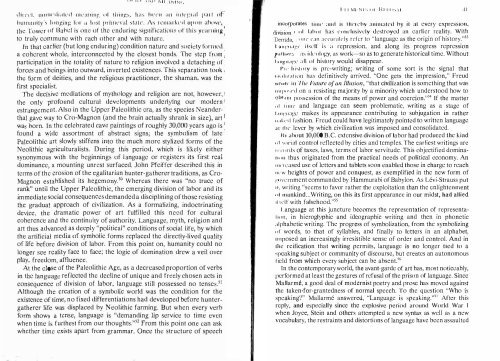CONTENTS - ouroboros ponderosa
CONTENTS - ouroboros ponderosa
CONTENTS - ouroboros ponderosa
You also want an ePaper? Increase the reach of your titles
YUMPU automatically turns print PDFs into web optimized ePapers that Google loves.
' . 1 ' II, \IJ ) 1\ 11 ,\NINr ,<br />
diICl"i, 1IIIIIWdi;lInI IllC;tllill}', lll" thillgs, has h(,(,11 ;111 illlql ;d p;1l 1 of<br />
hUII1,lIlily's IOllgi!lg fl ll' tt losl pr illH.'val slale. As ITlllarl-.l'd UpOl1 ahovt\<br />
th T()wr of Babel i one of the enu uring significations of tili, y"al'lliIlN '<br />
to truly commune with each other anu with nature.<br />
In that carlier (but long enduring) condition nature and s(lcity t(lrJlll',I .<br />
a cohcrent whole, interconnected by the closest bonds. The step from ,<br />
participation in the totality of nature to religion involved a detaching of<br />
forces and beings into outward, inverteu existences. This separation took ,<br />
the form of deities, and the religious practitioner, the shaman, was the<br />
first specialist.<br />
The decisive mediations of mythology and religion are not, however, '<br />
the only profound cultural developments underlying our modern I<br />
estrangcment. Also in the Upper Paleolithic era, as the species Neander· ·<br />
thaI gave way to Cro-Magnon (and the brain actually shrank in size), art 1<br />
was born. [n the celebrated cave paintings of roughly 30,000 years ago is ;<br />
found a wide assortment of abstract signs; the symbolism of late '<br />
Paleolithic art slowly stiffens into the much more stylized forms of the<br />
Neolithic agriculturalists. During this period, which is likely either<br />
synonymous with the beginnings of language or registers its first real<br />
dominance, a mounting unrest surfaced. John Pfeiffer described this in<br />
terms of thc erosion of the egalitarian hunter-gatherer traditions, as Cro<br />
Magnon established its hegemony. so Whereas there was "no trace of<br />
rank" until the Upper Paleolithic, the emerging division of labor and its<br />
immediate social consequences demanded a disciplining of those rcsisting<br />
the gradual approach of civilization. As a formalizing, indoctrinating<br />
device, the dramatic power of art fulfilled this need for cultural<br />
cohercnce and the continuity of authority. Language, myth, religion and<br />
art thus advanced as deeply "political" conditions of social life, by which<br />
the artificial media of symbolic forms rcplaced the directly-lived quality<br />
of life before division of labor. From this point on, humanity could no<br />
longer see reality face to face; the logic of domination drew a veil over<br />
play, freedom, aft1uence.<br />
At the close of the Paleolithic Age, as a decreased proportion of verbs<br />
in the language reflected the decline of unique and fredy chosen acts in<br />
consequence o f division of labor, language still possessed no tenses.51<br />
Although the crcation of a symbolic world was the condition for the<br />
existence of time, no fixed differentiations had developed before hunter<br />
gatherer life was displaced by Neolithic farming. But when every verb<br />
fo rm shows a tcnse, language is "demanding lip service to time even<br />
when time is furthest from our thoughts."" From this point one can ask<br />
whether time exists apart from grammar. Once the structure of speech<br />
'<br />
I'l l t\ ll'NI>.; « II 1,1'1-1 1:-" \ 1 I I<br />
incoorates 1111H" ;11111 is IIh'n"hy illlil11;lll"d hy it at every cxprcssioll,<br />
divisi on I III tlhOf has ctlildusivciy ucstroycd an earlier reality. With<br />
Derrida, . IIIW C:tll accuralely refer to "language as the origin of history." S3<br />
I ll)',II.II'.t· itsdf is a repression, and along its progress repression<br />
!" ,I :is iri






